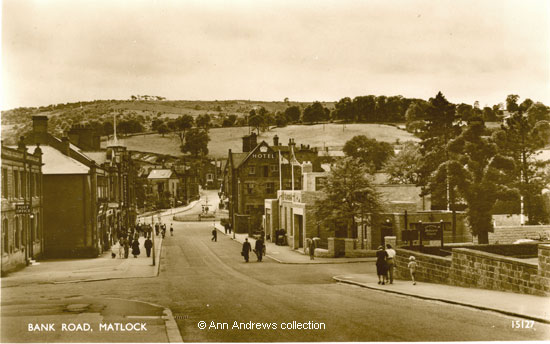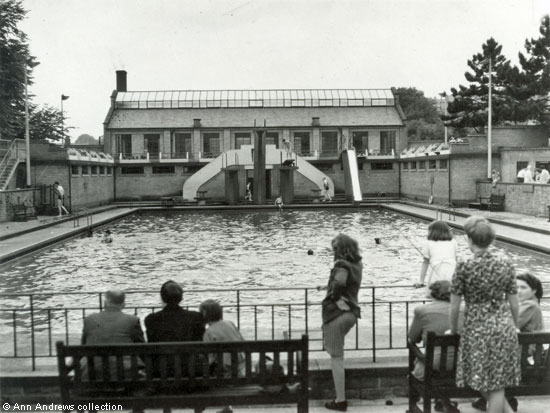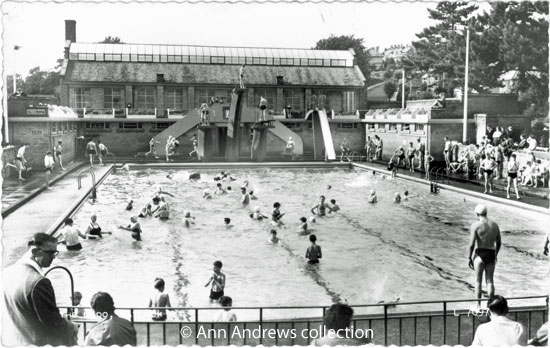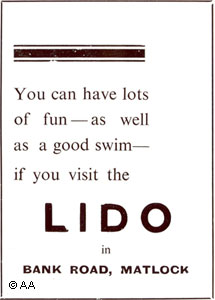|
Images Index> Matlock, 20th and 21stC Images> This page |
| Matlock: Bottom of Bank Road & The Lido |
| Matlock : Twentieth Century Photographs, Postcards, Engravings & Etchings |
|
|
||||||||||||
It was planned to build the Lido on Imperial Road Gardens behind the Crown Hotel[3] and opposite the Bank Road Post Office on "one of the fairest open spaces in the town" according to Mr. Eldridge, who was a member of the Chamber of Trade[2]. Ministry of Health approval of an £11,000 loan would be given on condition that an application for the removal of the restrictive covenant attached to the land was successful. This was eventually confirmed and on 18 June 1936 Matlock Urban Council announced agreement "in principle"' to the swimming pool scheme as the loan had been approved[4]. "The luxurious lido at Matlock" was heralded as a "welcome addition to the many amenities of one of Derbyshire's most beautiful spas"; it was opened by Brigadier G. M. Jackson of Clay Cross Hall on 26 May 1938 when he turned the water on. The pre-opening publicity said the Lido had been built at a final cost of £12,000 (later amended to almost £15,000 by the Ministry of Health) and offered "a delightful rendezvous for residents and visitors". The water in both the open air and covered swimming pools was to be heated to 72 degrees and continuously purified. Other amenities included ample sun-bathing facilities, evening flood lighting, a modern cafe, and adequate car parking[5]. Parking seems to perhaps have been an unnecessary priority in the early years as vehicles were non-existent in the top image (which appears to have been taken around the time the Lido opened), although they were perhaps referring to the weekend visitors. 
The Art Deco Lido building, with the pool entrance behind the woman who is standing at the road junction facing the camera. The cafe entrance was behind the three people with a pram on the left of this enlargement. A special parade of bathing beauties and diving exhibitions was included in the programme for the Lido's opening ceremony[5].
A Food Office was set up at the Lido in WW2. This was where people had to go to collect their Ration Books. Joyce Brenda Barker, who stayed with her grandmother during the war to avoid the bombing of her home town (Hull), worked here[13].
Post war, the Lido was first used for the Derbyshire Schools' Sports Association annual swimming gala in 1955[16]. The same year there was a proposal by Matlock U.D.C. for winter swimming sessions for schoolchildren[17]. A few years before this there had been several cases of polio in the town and some shunned the Lido. As for the cafe, it seems to have had several tenants during its lifetime. It was to let in 1950 and in 1955 the then tenant informed the Council that did not wish to continue with the lease so a committee was appointed to see if the cafe could become part of the Lido. At some stage, thought to be in the early 1950s, a gentleman called Herbert Siddons performed Carmen Miranda impersonations on the premises, presumably as a cabaret act[10]. The management was subsequently taken on by Mr. J and Mrs. A Simm who were there until its closure as a cafe. It catered for parties such as school reunions - Charles White's ex-pupils are known to have met up there and the scouts held an annual dinner at the Lido Cafe about 1975. A new roof was installed over the outdoor pool in the early 1970s. The cafe continued for some years but later became a nightclub. The cafe was eventually demolished and Wilkinson's, now Wilko, replaced it.
|
|||||||||||||
|
1 and 2. "Bank Road, Matlock". Published by J. Salmon Ltd., Sevenoaks. No.15127. Real Photo. Printed in England. Not posted. 3. [Matlock Lido, 1938]. No publisher although photograph taken by W. N. Statham. © Maureen Smith collection. 4. Photograph of the Lido, probably late 1940s. 5. "The Lido, Matlock". Published by Valentine, No. L7097. Registered in 1958 and posted on 30 Jul 1959 at Matlock. 6. "Matlock Lido and Cafe, Derbyshire". No publisher. PN1259. This is a real photograph. Not posted. 7. Advertisement from "The Matlocks, Derbyshire", guide book published in the 1950s. Geo. Hodgkinson, Printer, Matlock. 8. Advertisement from football club programme - F A Challenge Cup First Round Proper, Matlock Town v Wigan Athletic 20th November 1976. Geo. Hodgkinson, Printer, Matlock. © Susan Tomlinson collection. Images (apart from nos .3 and 7) in the collection of and provided by and © Ann Andrews. Researched, written by and © Ann Andrews. Intended for personal use only |
|||||||||||||
|
[1] "Sheffield Independent", 20 August 1935. Report of Council meeting. [2] "Sheffield Independent", 7 March 1936. Not everyone agreed with the sentiments expressed by Mr. Eldridge. Unfortunately, once the Hall Leys was developed little use was made of the Imperial Road Gardens. [3] "Derby Daily Telegraph",
18 March 1936. The Imperial Road Gardens site covered 3,893
square yards and had been bought by the Council in three separate
lots in 1900, 1901 and 1905.
[4] "ibid.", 19 May 1936. Minister Of Health and £11,000 Lido. Agreement In Principle To Matlock Scheme. Also reported in the "Belper News", 22 May 1936. One of the conditions of the original purchase was that the land should be maintained for ever as a recreation ground. The restriction had to be lifted. [5] "ibid.", 24 May 1938. The Lido was officially opened on May 26th at 2.30 p.m. [6] "Sheffield Independent", 27 May 1938. [7] "Derby Daily Telegraph", 26 May 1938. Matlock's £12,000 Lido opened. Mannequin Parade and Diving. [8] "ibid.", 30 May 1938. Derby Polo Team Win at Matlock. Celebrations at Lido Opening. [9] "Sheffield Independent", 25 June 1938. [10] With grateful thanks to the members of the WI. [11] "Derby Daily Telegraph", 23 March 1939. [12] "Derbyshire Times", 8 March 1940. [13] Food Offices were set up by the Ministry of Food. The 1939 Register shows Brenda was a typist, living with Rose Moore and uncle W. H. Moore on Bank Road. She married in Matlock the following year. The Food Office information comes from her son, Peter Cook. [14] "Derby Daily Telegraph", 2 August 1943. [15] "ibid.", 12 June 1950. Drowned in Lido. [16] "Belper News", 22 July 1955. [17] "ibid.", Jan 1955. |










